-
Car Reviews
- Car News
-
Car Comparisons
Latest comparisons
- Chasing Deals
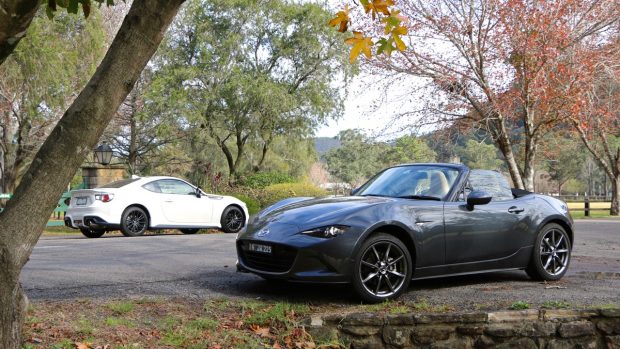
In terms of motoring fun, Australians have rarely had it so good. At a number of price points, we’re spoilt for choice.
In particular, the $60,000 range sees a number of hot hatches – many of which are faster than supercars of two decades ago. The Volkswagen Golf R and Ford Focus RS are sub-five second cars to 100km/h, but are well-equipped and comfortable for daily use.
The problem with those cars, though, is that they don’t offer something petrolheads demand: drive going to the rear wheels.
With inherent balance and ability to adjust handling with power, rear-wheel-drive offers great fun. For the enthusiast, the sensation of oversteer is as good as it gets.
And now is an exciting time to be into rear-drive, with two great sports cars available for under $40,000: the 2016 Toyota 86 and 2016 Mazda MX-5. Both cars hail from traditions of motoring ancestry. Being light and agile, they represent a deeply Japanese take on the sports car.
Both Toyota and Mazda are built around naturally-aspirated four-cylinders, though subtle differences make each feel quite unique on the road.
The 86 uses a Boxer two-litre flat-four sourced from Subaru: the two-door is a collaboration between Toyota and the rallying brand.
Meanwhile, the MX-5’s more traditional inline-fours are sourced in-house. We drove the torquey, high-compression two-litre, though many purists favour the lighter 1.5-litre that buzzes along, honouring the MX-5’s ‘momentum car’ roots.
Both engines are willing but their performance – in stock form, at least – is hardly chassis-troubling.
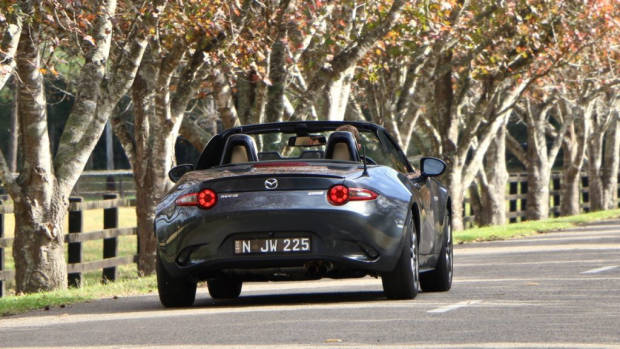
On paper, the 86 appears to be the faster car with a strong power advantage – 147kW to the Mazda’s 118kW, though torque is near-identical at 205Nm to 200Nm respectively.
However, with longer gearing, more distant peak torque and 200kg more mass to carry, the 86 only achieves level-pegging with the Mazda in a straight-line sprint.
Equipped with the two-litre, the Mazda makes the most of its torque in the mid-range. While it will happily pull in lower revs, the MX-5 flexes its muscles impressively in fourth, offering real flexibility and a decent turn of speed.
In-gear acceleration isn’t the point of revvy little two-doors, but the Mazda leaves us with a perception that it is the faster of the two.
The MX-5 also clearly pulls ahead in the fuel economy stakes, achieving a near-20% superior figure of 7.1L/100km over a spirited drive, to the Toyota’s 8.6L/100km.
With outright pace essentially ending in stalemate, finding the superior driver’s car is a question of handling.
Well, both deliver in spades.
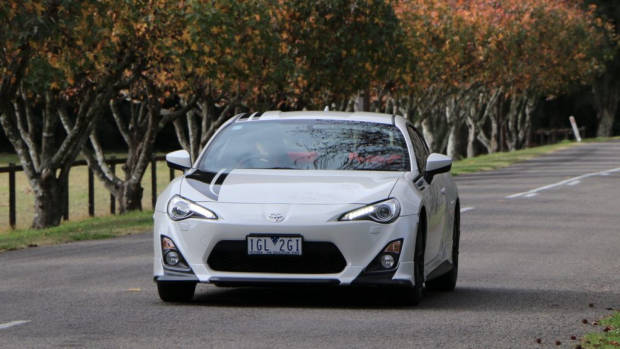
The 86 deserves its reputation as a truly impressive handler. The chassis is so tight, focussed and firm – wherever you point it at any speed, it goes there without a fight. The Toyota is a car that works with you, happily taking abuse, and asking for more.
Sharp steering inspires real confidence, but the wheel is also one of the most communicative on any car. Every bump and road imperfection is felt. The 86 is easily controllable in oversteer – which is also easily achievable by pushing just a little more power to the rear wheels during virtually any corner. The traction control allows a soft, limited, relaxed slip that flatters your driving skills.
The manual gearbox is notchy with a longer throw. The clutch is heavy and feels sporting, though it takes some adjustment and is unforgiving of poor shifts.
While it’s stiffly sprung, it’s not punishing – thanks, in part, to comfortable seats. The 86 retains some forgiveness – stroking your ego and making you feel like a better driver. Like great cars do, it is easy to drive and to drive fast.
Looking at the MX-5, it would be to assume its diminutive size would produce an unrefined chassis with a crashy ride. We were surprised to find that – by quite a margin – the Mazda is the more comfortable car.
Clear contrasts emerge after taking off in the MX-5. The chassis keeps an element of focus, but it is softer, more relaxed: this is the car you’d drive every day.
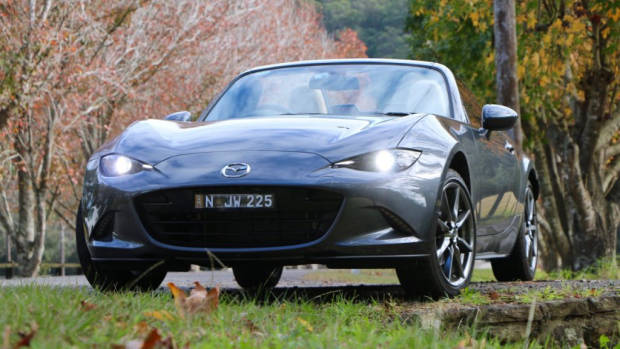
The steering is quick but lighter than that in the Toyota, but the point-and-squirt factor that makes the 86 a great car can be felt even more powerfully in the Mazda.
That’s because the MX-5 rides on a wider track and is 200kg down on the 1198kg Toyota: despite its complement of modern safety gear and cabin technology, the Mazda is a genuine one-tonne car.
Initially, we are less confident in the Mazda as the steering offers less meat than the Toyota – but you quickly adjust and learn that the MX-5 offers creamy, intoxicating dynamics that force you to just keep driving. The ebb and flow of a mountain road is best enjoyed from the driver’s seat of a Mazda MX-5.
We recommend the Mazda’s manual transmission, which has an amusingly short throw and comfortable ball-like shifter. The shift is lovely and buttery.
There is body roll – where the 86 is flat and planted, the MX-5 leans on its outboard rear wheel and pushes against it through a corner. The yawing might be unexpected, but the Mazda’s lightness means it actually adds to the feeling of engagement.
The variances between this pair go beyond unique approaches to the ride-handling balance – their interiors are very different places.
Both are products of their time – the Toyota was launched in 2012, and the Mazda is three years’ newer.
The Toyota has the superior seat, with aggressive side bolstering and an attractive mix of leather and alcantara materials.
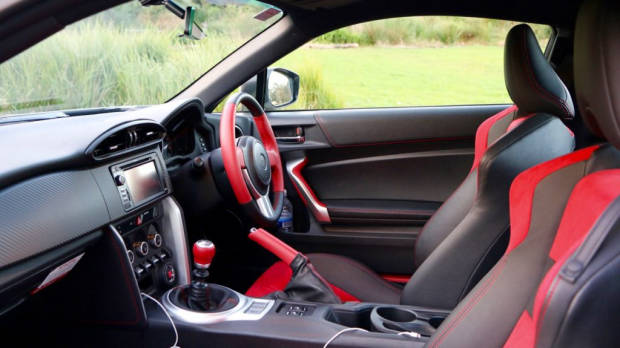
However, interior design has moved on rapidly and the Toyota now feels dated.
The vertical dashboard looks severe and the navigation touchscreen is problematic. With no controls on the steering wheel, relying on the screen’s tiny buttons makes it hard to change songs on the move.
Mazda have designed a standout interior for the MX-5 – it looks good and makes the most of limited space.
The seats need more side bolstering, but the leather is of a decent quality and the driving position is even better than that in the Toyota.
Many of the Mazda’s controls have a nicely-weighted metallic feeling and the stitched fascia to the dashboard and rotary air vents are quite classic.
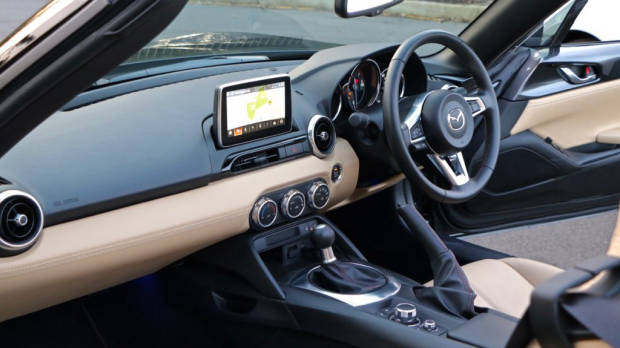
The inclusion of Mazda’s MZD Connect navigation system is a win, offering both touch and a rotary controller between the seats. Not only is the screen smaller, but it is much easier to use – plus, there are controls on the steering wheel.
The Bose stereo holds up quite well with the roof down, and does a better job at reproducing your music than the Toyota’s distant-sounding audio.
Apple CarPlay and Android Auto will soon be made available on the MX-5, including to existing cars through a service software upgrade.
Of course, the 86 is a coupe with rear seats and the MX-5 is a mere two-seater convertible. However, the 86’s rear seats are so restricted that most will use them as a parcel shelf – any passenger above about 5’9” will hit their head on the rear glass.
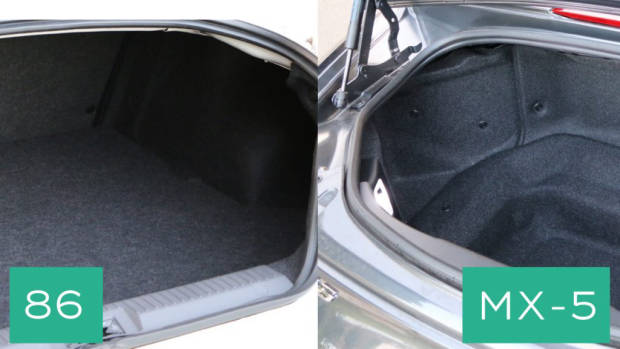
But the Toyota pulls ahead significantly in boot space, and is the more practical car. The Mazda’s tiny 130-litre boot will fit only a couple of soft overnight bags; the Toyota’s 218 litre boot expands with folding seats to make a much more flexible space.
Neither car features as a spare wheel, though Toyota will sell you one – however it consumes a chunk of the 86’s boot space.
If you wanted practicality, though, you would be looking at a Golf GTI.
Though we reviewed the high-spec trim of each car, the 86 and MX-5 are both available from about $30,000. Rarely has so much fun been available for so little.
If you can’t stretch to a high-spec – or high-output, in the Mazda’s case – model, the base cars are relatively well equipped.
Both the 86 GT and MX-5 1.5-litre arrive with 16-inch wheels, air conditioning, Bluetooth audio, stability control and LED taillights. Manual models also score a limited-slip differential as standard on both cars.
But you can spend more – and both cars here push $40,000 in standard form, although the Toyota’s special-edition Blackline body kit, based on the GTS spec, goes even further north.
In $35,990 GTS form, the Toyota adds a fiddly touchscreen navigation system, bi-xenon headlights, a reversing camera, comfortable leather-alcantara seats and dual-zone climate control. Outside, there are larger 17-inch wheels and and more aggressive styling.
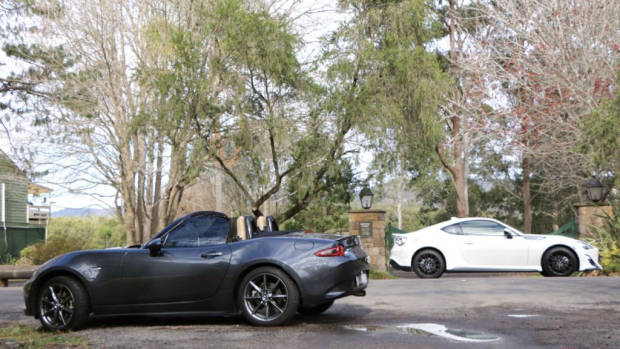
The MX-5 GT asks $39,550 – but you get more. The Mazda adds supple, full-leather seating, automatic LED headlights, and automatic wipers. Crucially, it’s much better inside, with Mazda’s MZD Connect navigation system with a rotary controller between the seats, paired to a nine-speaker Bose stereo.
Both cars demand premium fuel, but the Mazda’s weight advantage means it uses about ten per cent less petrol.
Warranties are three years or 100,000 kilometres here, and a capped price servicing programme is also offered on both cars.
Service intervals end up about the same – 9 months or 15,000 kilometres in the Toyota; a year or 10,000 kilometres in the Mazda. But over three years, the Toyota is the cheaper car to service, costing $720 to the Mazda’s $1,027.
In determining a winner, many of the Toyota’s detriments barely counted against it.
The Toyota’s interior might be dated next to the Mazda’s great cabin, but interiors were not the point of this competition.
If this was a competition fought on sharp handling, the Toyota would claim an easy victory. The chassis remains an absolute marvel – one of the best on sale at any price. The engaging drivability of the Toyota 86 is still deeply charming.
However, sharpness is an element the Mazda also delivers – in a different way. The MX-5 encourages you to push on and on, flowing in and out of corners, engaging with each of the control surfaces – accelerator, steering, brake – and learning how the car responds to delicate, rather than brutal, inputs.
The classic tradition of open-top motoring also favours the Mazda, giving the driver an even greater sense of connection to the roads and environments in which we drive.
This was a day of motoring in cars that combine great fun with real value. Both are talented driver’s cars.
The winner was the car that made us feel a deeper sense of being at one with the machine – and that car is the 2016 Mazda MX-5 GT 2.0L.
Jake Williams and Tom Baker
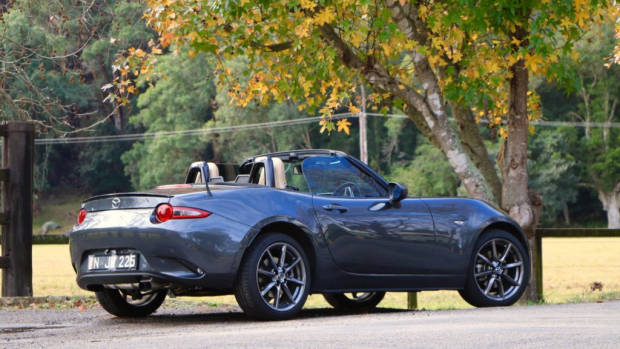
Latest comparisons
About Chasing cars
Chasing Cars reviews are 100% independent.
Because we are powered by Budget Direct Insurance, we don’t receive advertising or sales revenue from car manufacturers.
We’re truly independent – giving you Australia’s best car reviews.